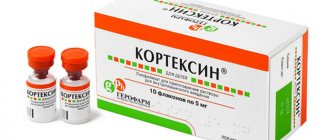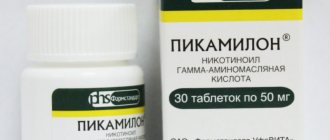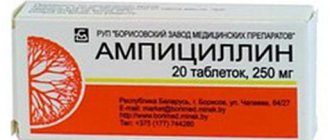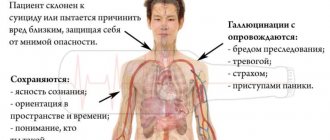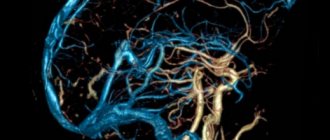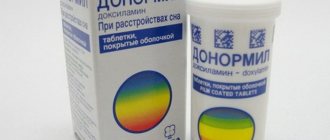Composition, properties and release form
Grandaxin is a drug that has anxiolytic properties
Grandaxin belongs to the group of tranquilizers and has an anxiolytic effect. This remedy helps eliminate feelings of fear, anxiety, and nervous tension.
The active active substance of the drug is tofisopam. The drug has a calming effect and also produces disinhibitory and activating effects.
Unlike most tranquilizers, it does not have a hypnotic effect and can be used during the daytime. The effect of the drug is observed within 2 hours. Absorption occurs in the gastrointestinal tract and is then excreted from the body along with urine.
The active substance does not accumulate in tissues and organs.
Grandaxin is sold in tablet form. They are flat, round and white. One tablet contains 50 mg of tofisopam, the active substance. In addition to tofisopam, the drug contains some excipients: stearic acid, magnesium stearate, talc, potato starch, gelatin, etc.
Drug interactions
- Metoclopramide enhances the absorption of Grandaxin, and therefore its effect occurs faster.
- Grandaxin increases the blood concentration of Cyclosporine, Sirolimus, Tacrolimus when used simultaneously, so these drugs are not used together.
- Grandaxin enhances the effect of drugs that suppress the function of the central nervous system (painkillers, antidepressants, general anesthesia, hypnotics, antipsychotics and sedatives), up to respiratory depression.
- Enhancers (inducers) of the production of liver enzymes (barbiturates, nicotine, antiepileptic drugs, alcohol) cause a decrease in the concentration in the blood and a weakening of the action of Grandaxin.
- Antifungal drugs (Itraconazole, Ketoconazole) slow down the conversion of Grandaxin in the liver and help increase the concentration of the drug in the blood.
- The therapeutic effect of Grandaxin can be enhanced by some antihypertensive drugs (calcium channel blockers, Clonidine).
- Grandaxin may increase the concentration of Digoxin in the blood.
- Benzodiazepines (including Grandaxin) can change the anticoagulant effect of Warfarin.
- Antacids may have an inhibitory effect on the absorption of Grandaxin.
- Long-term concomitant use of Disulfiram may suppress the conversion (metabolism) of Grandaxin.
- Omeprazole, Cimetidine, and tablet contraceptives reduce the intensity of Grandaxin transformations.
The annotation for the medicine states that the drug has an anxiolytic effect.
When taking Grandaxin, the following side effects may occur:
- constipation, nausea, loss of appetite, dry mouth, gas, in some cases - congestive jaundice;
- insomnia, headache, irritability, psychomotor agitation; in patients with epilepsy, seizures and confusion may begin;
- itching, exanthema (including scarlet fever);
- muscle pain and tension;
- difficulty breathing.
The simultaneous use of Grandaxin with tacrolimus, cyclosporine, sirolimus is prohibited.
When taking Tofizopam with drugs that suppress the functions of the central nervous system (sedatives, hypnotics, analgesics, antipsychotics, antidepressants, general anesthesia, etc.), their sedative effect is enhanced.
Nicotine, alcohol, antiepileptic drugs, barbiturates can speed up metabolism, which will lead to a decrease in the concentration of the drug in the blood and a decrease in its therapeutic effect.
Some antifungal drugs (such as kitraconazole and ketoconazole) can slow down the metabolism of the drug and lead to an increase in its concentration in the blood.
Antihypertensive drugs such as calcium channel antagonists and clodinedine may enhance the effect of the active substance Grandaxin.
When is the drug prescribed?
Most often, the drug is indicated for VSD, neurosis and depression.
Grandaxin is a sedative and can be used in the following conditions:
- Neuroses.
- Climax.
- Premenstrual syndrome.
- Cardialgia.
- Muscular atrophy of a neurogenic nature.
- Post-traumatic syndrome.
- Reactions to strong external stimuli.
It is advisable to use the drug for various pathologies of the nervous system, accompanied by depression, emotional stress, feelings of anxiety and tension.
The drug can be prescribed for neuromuscular diseases, autonomic disorders, and withdrawal syndrome. In addition, Grandaxin can be used together with other drugs in the treatment of bulimia.
Grandaxin in cardiology
Cardiologists can prescribe the use of Grandaxin for vegetative-vascular dystonia or for patients after a stroke. Autonomic disorders are characterized by anxiety, depression, and dysfunction of the cardiovascular system. Ischemic disease and hypertension in most cases are accompanied by autonomic disorders.
More information about the drug Grandaxin can be found in the video:
Use during pregnancy and lactation
What are Grandaxin tablets for? Here are the indications for use of the drug:
- premenstrual syndrome;
- mental adjustment disorder;
- alcohol withdrawal syndrome;
- menopausal syndrome;
- cardialgia;
- myopathies, myasthenia;
- neurogenic muscle atrophy, as well as other pathological conditions (in case anxiolytics with muscle relaxant effects are contraindicated);
- neuroses;
- neurosis-like states (emotional stress, anxiety, autonomic disorder, apathy, worry, decreased activity).
Grandaxin is also prescribed for VSD (vegetative-vascular dystonia).
The drug should not be taken in the following cases:
- hypersensitivity to any component of the drug;
- 1st trimester of pregnancy, breastfeeding;
- psychomotor agitation, aggressiveness, depression;
- decompensated respiratory failure;
- respiratory arrest syndrome (during sleep).
The drug should not be used simultaneously with Sirolimus, Tacrolimus, or Cyclosporine.
The drug contains lactose monohydrate, so it is not recommended for patients with galactose intolerance, congenital lactase deficiency, as well as patients suffering from glucose and malactose malabsorption syndrome.
The medicine is taken orally. The dosage size is set individually depending on the general condition of the patient, individual tolerance to the drug and the clinical form of the disease. Adults are usually prescribed 1-2 tablets per day (50-100 mg) up to 3 times a day. For irregular consumption, the dose is set at 1-2 tablets.
The maximum allowed dose per day is 300 mg.
Instructions for Grandaxin for elderly people (over 65) and patients with kidney failure: the daily dose of the drug is reduced by 2 times.
Before taking the medicine, be sure to consult your doctor.
When taking doses of 50-150 mg/kg, effects of decreased central nervous system function may occur. This dose can cause vomiting, coma, respiratory depression, confusion, and epileptic seizures.
If symptoms of overdose occur, do not induce vomiting. It is necessary to rinse the stomach, take activated charcoal, which will reduce the absorption of the substance, and apply symptomatic treatment.
In case of respiratory depression, mechanical ventilation is performed; CNS stimulants should not be administered.
For hypotension, it is recommended to administer intravenous fluids and move the patient into the Trendelenburg position. If the above measures do not lead to normalization of blood pressure, norepinephrine or dopamine should be administered.
- Neuroses (as well as neurosis-like conditions), accompanied by various fears, anxiety, nervous tension or, on the contrary, apathy, lethargy, and indifference to the environment.
- Violation of psychological adaptation due to stress.
- Reaction to stress in the form of depression with elements of psychopathy.
- Premenstrual syndrome.
- Increased nervous excitability during menopause.
- Heart pain of various origins.
- Hangover (withdrawal) syndrome in chronic alcoholism.
- Neurotic disorders in myopathy, myasthenia gravis, muscle atrophy (i.e. in cases where tranquilizers that relax muscles are contraindicated).
Contraindications
- Increased individual sensitivity to the drug or to one of its components;
- neurotic states with severe aggression, excessive emotional and motor arousal or deep depression;
- pregnancy in the first trimester;
- breastfeeding period;
- sleep apnea (ever occurred before);
- simultaneous use with drugs such as cephalosporins, Sirolimus, Tacrolimus;
- malabsorption of galactose and glucose, congenital lactase deficiency, galactose intolerance.
- epilepsy;
- severe cerebral atherosclerosis;
- other organic brain lesions;
- angle-closure glaucoma;
- history of acute respiratory failure;
- chronic RDS syndrome (respiratory distress syndrome) in the stage of decompensation.
Side effects
When treated with Grandaxin, side effects from various organs and systems may occur:
- From the central nervous system - headaches, sleep disturbances, increased nervous excitability, irritability. Confusion may develop. In patients with epilepsy, there is an increase in seizures.
- From the digestive tract - decreased appetite, feeling of dry mouth, nausea, flatulence (increased gas formation in the intestines), constipation. Rarely, the development of congestive jaundice occurs.
- From the respiratory system – respiratory depression.
- From the musculoskeletal system – muscle pain, tension of various muscle groups.
- Allergic reactions: skin itching, various skin rashes (including scarlet fever).
Grandaxin is taken regardless of meals. The drug does not cause addiction, mental or physical dependence. There is no withdrawal syndrome either. The drug does not reduce reaction speed and concentration, so there are no professional restrictions during treatment with Grandaxin. To prevent sleep disturbances (falling asleep), it is recommended to take the drug no later than 15-16 hours.
Dosage The doctor selects the dose of Grandaxin individually for the patient depending on the clinical indications, the severity of the condition and the patient’s sensitivity to the drug.
The average daily dose for adults is 50-100 mg (1-2 tablets). The frequency of taking the drug is 1-3 times. per day. The maximum dose per day is 300 mg.
For patients over 65 years of age and with renal failure, doses reduced by 2 times are used. The duration of the course of treatment is determined by the doctor. For alcohol withdrawal syndrome, for the treatment and prevention of delirium tremens, the course duration can be up to 6 weeks.
In the first 3 months
Grandaxin is not used. Subsequently, Grandaxin is prescribed to a pregnant woman in exceptional cases when the expected benefit of treatment outweighs the risk of a negative effect of the drug on the developing fetus.
Breastfeeding should be stopped during treatment with Grandaxin.
In the first 3 months
Price of the drug in Russia and Ukraine
The price of Grandaxin tablets in Russia is: a package of 20 tablets - 220-260 rubles, a package of 60 tablets - 475-538 rubles. You can buy the drug in Moscow at any pharmacy if you have a prescription from a doctor.
Price in Ukraine: the cost of a package of 20 tablets is 150 UAH, a package of 60 tablets is 215 UAH.
Here are the average prices for the medicine; to find out exactly how much Grandaxin costs in your region, you need to contact the pharmacy directly.
In Russia and Ukraine, the drug is available by prescription.
How long after taking the medicine can you drink?
During therapy, the consumption of strong drinks should be avoided. However, if the treatment coincides with a special event at which drinking will be present, the interval between the sedative and alcohol should be at least 8 hours. This period is enough for the active components of the medication to at least partially leave the body.
If possible, it is better to wait 16 hours so that the blood is completely cleared of the drug. It should be noted that alcohol in any case should not be strong. Excessive drinking can cause complications.
Grandaxin can be used if a hangover develops. However, pills should be taken only after alcohol decomposition products have been completely eliminated. Then you can begin a course of treatment with a sedative.
How to recognize depression
As already mentioned, the drug helps get rid of depression, but not all of its forms. Grandaxin is taken only for mild to moderate disease with moderately severe symptoms.
During the course of the disease, several syndromes are distinguished:
- Emotional disorders: low mood, melancholy, anxiety and internal tension, pessimistic attitude; self-flagellation, lack of interest in the world around us, inability to have fun.
- Behavioral reactions: solitude, reduced activity; bad habits;
- Cognitive functions: inability to concentrate, slow thinking, decreased memory and perception; pessimistic thoughts, thoughts of suicide, low self-esteem.
- Autonomic disorders: poor sleep, appetite distortion, weakness and malaise, intestinal dysfunction; discomfort in the heart and other organs, headaches.
A specific indication for the use of the drug is reactive depression. It develops in response to the action of some traumatic factor. The condition is characterized by a consistently reduced emotional background and fixation on the problem.
The patient reproaches and blames himself for what happened, his conversations are aimed only at the problem. And, constantly analyzing it, he seeks support from those around him.
A person is worried about insomnia. And he is fully aware of his condition.
Overdose
The visible manifestation is a dysfunction of the central nervous system. Confusion, respiratory depression, vomiting, and coma are recorded. Observed with a single dose of Grandaxin at a high dosage of 50 mg/kg of patient weight. To reduce the absorption of the drug, activated carbon is prescribed.
Gastric lavage is undesirable due to inhibition of the central nervous system. The administration of central nervous system stimulants is also not recommended. In serious overdose situations, Dopamine, Norepinephrine and artificial ventilation are prescribed.
Indications and contraindications
The drug is prescribed for mild depression. The product helps women during premenstrual syndrome. A sedative medication allows you to cope with muscle atrophy, myopathy and obsessive-compulsive disorder.
Grandaxin is prescribed for VSD (vegetative-vascular dystonia).
Sedative tablets also have contraindications. The latter include shock and coma and dependence on psychotropic drugs. It is prohibited to take the medicine while carrying and feeding a child.
The use of Grandaxin should be avoided if you are allergic to its components. The sedative is not prescribed to elderly people and persons under 18 years of age. Before starting to use the medication, you should consult your doctor. Only a specialist, after analyzing the medical history and clinical picture, can accurately determine whether the patient can take the drug.
Grandaxin - side effects
Like almost every medicine, this drug has a number of side effects. Why are they important to consider when prescribing Grandaxin - side effects can practically neutralize the positive effect of the drug on a person’s well-being. According to reviews, during the course of treatment with this drug the following undesirable manifestations are common:
- headache, psychomotor agitation, insomnia;
- difficulty breathing;
- muscle tension and pain;
- loss of appetite, nausea, gas formation, constipation;
- skin itching, exanthema, etc.
Instructions for use
Grandaxin tablets are taken orally whole, without chewing and with a sufficient amount of liquid. The dosage is set individually, depending on the underlying pathological process and the severity of neurological or mental manifestations.
The average dosage for adults is 50-100 mg (1-2 tablets) 1-3 times a day. The maximum daily dose should not exceed 300 mg. For children over 14 years of age, the maximum daily dose is 200 mg. For elderly people and people with renal failure, the dose is reduced by 2 times.
When treating a sleep disorder or the presence of concomitant insomnia, the last pill should not be taken later than 15-16 hours of the day. The duration of the course of therapy is also determined individually.
Consequences of co-administration
Not everyone knows whether it is possible to drink alcohol while taking Grandaxin. A careless attitude towards one's health often becomes the cause of the development of various anomalies.
Tandem is capable of causing:
- significant decrease in blood pressure (blood pressure);
- breathing problems;
- dizziness;
- pain syndrome;
- outbursts of aggression;
- absent-mindedness;
- disorientation in space;
- mood swings;
- drowsy state;
- vomiting and nausea.
The patient may also experience problems with the digestive system. The combination of alcohol with the drug has a negative effect on kidney function. Some drunkards begin to have thoughts of suicide.
If you drink while being treated with a sedative, problems arise with the correct diagnosis. A specialist may mistake an allergic reaction to a tandem for intolerance to the components of the medication. Therefore, it is better to refuse this combination.
Alcohol and Grandaxin
It is undesirable to combine any medications with alcohol consumption. This is especially true for tranquilizers, which include Grandaxin. When used together, the consequences can be very undesirable and severe: the effect on the nervous system increases, which can lead to severe side effects up to
and respiratory depression.
In addition, severe headaches, sleep disturbances, irritability, and allergic reactions may occur.
In patients with concomitant liver pathology and in persons suffering from chronic alcoholism, the undesirable effects on the liver (both of the drug and of alcohol) will worsen.
The purpose of prescribing Grandaxin is to relieve the patient of tension, depression, and fears. When combined with alcohol, you should not count on the effectiveness of the drug.
Alcohol reduces the effectiveness of any drug, so Grandaxin is not compatible with alcohol. Simultaneous use increases the load on the liver and also increases the likelihood of side effects.



